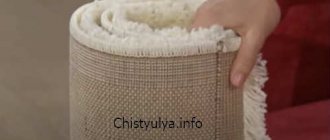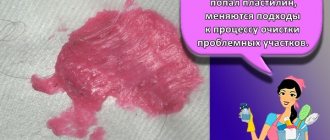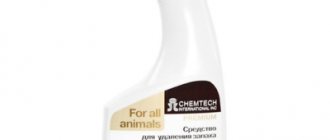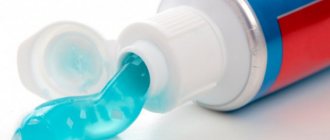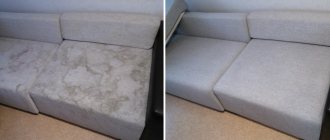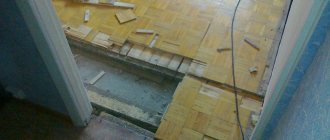The brilliant green solution has a strong coloring effect. If the product gets on the flooring or upholstered furniture, you should immediately try to remove it. The more time passes, the less chance there is to remove emerald stains. Zelenka eats into any surface. It is easiest to deal with “blots” on linoleum; it is more difficult to deal with carpet and textile furniture upholstery.
Always choose a stain removal method based on the surface characteristics. If you need to clean carpet or textile upholstery, first test the product on an inconspicuous area.
How to wash brilliant green from linoleum: removing a fresh stain
You knocked over a bottle of “diamond” solution, and now there are emerald “blots” on the floor and you don’t know how to erase it? Act quickly and there will be no green marks left on the linoleum. Don’t forget to be careful: although linoleum is not afraid of aggressive agents, abrasives can leave scratches on the surface.
How to remove and get rid of brilliant green from linoleum forever if the incident has just happened? This can be done in two steps.
- Blot the “blots” thoroughly. Do not let the solution soak in. Take a sponge, scrap cloth, paper napkins, or even toilet paper—whatever you have on hand will do. Blot the area where the brilliant green has spilled repeatedly: as a result, only traces should remain on the floor, but not liquid. You need to blot it point by point, starting from the edges, and under no circumstances smear it, otherwise the scale of the disaster will increase. Before blotting, you can use natural absorbents - salt, starch, soda powder.
- Wash away stains. How to clean brilliant green from the floor? If the solution has just spilled on the linoleum, and you have collected as much liquid as possible, then you can wash away the traces with a soap solution. To prepare it, use laundry soap, dishwashing detergent, and washing powder.
If you have a Vanish type stain remover in your home, use it. Although stain removers are created to save clothes, in concentrated form they are capable of removing complex “blots” from any surface. Linoleum is not afraid of liquid and gel-like chemicals.
Removing greenery at the dacha
All recommendations are quite applicable in dacha conditions.
But this has its own characteristics, since the furniture and interior elements are made of inexpensive materials. Country houses and plots are usually furnished with plastic furniture. Does it seem like a fairly simple task to wipe off the green paint from plastic? Indeed, if the plastic is white, then chlorine-containing products will quickly discolor the stain. But when the plastic is colored, it’s a different situation. You can wash green stains from furniture made of colored plastic in several ways. You should react quickly to a green stain - try to wash it with soap or washing powder. It’s good if you have alcohol or an alcohol wipe on hand. As a last resort, wash with kerosene or gasoline; these are very effective products, although they have a pungent odor. In the conditions of a garden plot, ventilation will not take much time.
If brilliant green gets on laminate or parquet
Can green paint be washed off from parquet? The success of the event will depend on whether the surface is varnished or not. But in any case, be prepared for the fact that after removing the marks, restoration work on the surface of the coating may be necessary.
- Laminate. If brilliant green gets on the laminate, try rubbing it off with an eraser. You can take a stationery eraser or a special one for suede. A fresh stain is first blotted with a napkin, an old stain is moistened with water. To be more effective, the gum can be soaked in an alcohol solution. It will take a long time to rub, but if the marks are small, you won’t have time to get tired of the procedure. The method can be applied to any varnished surface.
- Wooden floor. Wooden surfaces can be easily cleaned with acetone-containing products. However, along with the green marks, the varnish also goes away. Polished surfaces can be treated with medical alcohol, a window cleaner.
- Parquet. It is impossible to remove brilliant green from the parquet if it is not varnished. In this situation, even the most effective means are powerless. Parquet board without varnish has a porous structure, which is why it absorbs the coloring solution with lightning speed. The only way out is to sand the top layer. It is better to entrust such manipulation to professionals.
Sanding is also used when “blots” cannot be removed from a varnished wooden surface. The sanded area is re-varnished.
Why is such an indispensable antiseptic not used in the West?
Zelenka became especially popular in the USSR. Firstly, it could be stored for a long time, and secondly, its production was quite simple and cheap. To this day, it is found in almost every home medicine cabinet.
Apart from Russia and several post-Soviet countries, our usual brilliant green is not used in medicine anywhere else, although it can be bought in pharmacies.
What is the reason for such dislike of foreign medicine for brilliant green? It is difficult to answer precisely, but there are several complementary versions that try to somehow explain this phenomenon.
- Aesthetic factor
First of all, the green spots are too bright and look terribly ugly on the skin. In the West, various colorless ointments are more popular, which contain antibiotics, colorless Castellani liquid with a similar effect, mercurochrome and a mixture of betadine (an iodine compound) with sugar.DepositPhotos
- Insufficient knowledge
In Western countries, the doctrine of evidence-based medicine has been adopted, and the mechanism of the effect of brilliant green on the body remains only hypothetical to this day, as does the assumption of its possible toxicity and even carcinogenicity. No one undertakes to prove or disprove this theory.“The molecular mechanism of action of brilliant green and other dyes is still unknown. To find out, it is necessary to conduct complex and expensive studies. And who will do this for such an old drug?” - explains the dean of the Faculty of Pharmacy of the Russian State Medical University, Professor Ivan Kozlov.
- Lack of efficiency
“Zelenka is an alcohol solution of a dye. The antiseptic in this case is alcohol, and it dries out the skin greatly. Therefore, if you lubricate pimples (including chickenpox), redness, and papules with brilliant green, the situation will only worsen.In order for the doctor to figure out what is under the brilliant green, he must first wash it off. It has been proven that a dirty wound should be washed with soap and water, and not filled with brilliant green. Or use alcohol,” comments Pavel Vorobiev, professor at the Sechenov First Moscow State Medical University.
Nowadays, of course, there are much more effective and modern antiseptics than brilliant green. But in cases where, for example, there is nothing else at hand, it makes sense to use this simple, affordable and time-tested remedy.
I heard from my grandmother about “magic iodine.” "So simple!" will share a recipe for its preparation and tell you what diseases “magic iodine” can be used to treat.
No one is safe from a sudden attack of pain. Always keep an emergency kit on hand. It should contain not only a patch and brilliant green, but also mandatory medications, a list of which we bring to your attention.
If there is a drug that treats effectively and quickly, it is Iodinol. It costs a penny, but saves you from a lot of trouble! We talk about 11 effective ways to use this cheap medicine.
Removing marks on the carpet
How to remove green stains from a carpet? Much depends on the size of the “blot” and how long it spent on the carpet. You need to act immediately; on the second day, the brilliant green solution will be absorbed into the pile and it will be much more difficult to remove the dye without leaving a trace.
If the stain is fresh...
- Gently blot the area filled with greenery with napkins or unnecessary rags. Make sure that the maximum amount of emerald substance is absorbed into the rags.
- Add the powder to the water and create a foam.
- Apply with a brush to the carpet. Rub the stain. For difficult cases, it is recommended to leave the foam for an hour.
- Remove the foam with a sponge soaked in water.
- Dry the carpet. If the size of the coating allows, dry in the fresh air. Otherwise, blow drying will do.
To treat colored carpets, use a powder with added stain remover; for light-colored carpets, use a powder with bleaching properties.
...and if it's old
- Soak a cotton pad with 10% ammonia.
- Test the product on an inconspicuous area.
- If the test shows that the carpet does not lose color, then treat the stain.
- Repeat the procedure until the emerald “blot” disappears.
Alcohol can be replaced with peroxide. But only if the carpet is light. On dark material, peroxide can leave whitish streaks and discolored areas.
How did the brilliant green appear?
In 1856, 18-year-old English chemist William Perkin tried to create a cure for malaria from coal tar. A by-product of his experiments was a radical-purple substance, which was later called mauveine (from the English name for the mallow flower - mauveine).
Further experiments showed that mauvais dyed silk so that the color remained even after washing and exposure to sunlight. Later, other organic dyes were synthesized: from black to yellow, including brilliant green.
DepositPhotos
Aniline dyes have become firmly established. In biochemistry, they were used to stain preparations in order to better see the life of microorganisms under a microscope. In 1879, German scientists noticed that all microorganisms painted brilliant green die. From that moment on, the medical career of the antiseptic known to us all began.
How to save a sofa: methods for different types of upholstery
Did you stain your sofa with a solution of brilliant green? Don't rush to cover up stains with a blanket. It is difficult to remove brilliant green from furniture, but nothing is impossible. To restore the cleanliness of your sofa, you need to consider the type of upholstery. It is advisable to test the “green remover” on an inconspicuous area and only then apply the product directly to the stain.
Textile
- Prepare a paste from the powder and a small amount of water.
- Apply to fabric upholstery.
- After complete drying, remove the product. The dried pulp will be colored green.
- Gently rinse the treated area with water. You need to make sure that the liquid does not saturate the filling of upholstered furniture: this can provoke the appearance of fungus.
The products that housewives use to clean carpets - ammonia, peroxide - will help clean dried green stuff from a sofa upholstered in fabric. However, if you doubt your abilities and are afraid of ruining the sofa, it is better to order professional dry cleaning.
Leatherette
- Prepare a paste of potato starch and water.
- Treat the leatherette.
- Leave until completely dry.
- Clean off carefully.
Starch cleaning will help if the eco-leather has just been stained. To combat old “blots” you will have to use solvents, for example, white spirit.
Leather
- Dissolve a teaspoon of citric acid in a glass of warm water.
- Try washing the brilliant green from a leather sofa.
- After treatment, lubricate the surface with any cosmetic cream. This is necessary so that the natural material does not dry out or crack.
Housewives believe that cleaning green stains from carpets and upholstery is the most difficult task. But they forget that the dye can get on the wallpaper: this is where you really have to work hard. To remove it, you can use peroxide, alcohol, or soda powder, but there are no guarantees that everything will work out. In addition, only non-woven and vinyl wallpapers can be cleaned. If the product gets on paper, you will have to seal the stained area or re-glue the wallpaper completely.
Fighting old stains
An old green stain is difficult to remove and, in some cases, completely impossible to remove. But there are still several effective options that can remove most of the contaminants.
- Acetone. The solvent must be used carefully and not overuse the substance, as it can discolor the coating. The liquid should be poured onto a cotton swab and treated the affected areas of the floor.
- Bleaching powder. This substance is sold in pharmacies in the form of a powder, which must be diluted with water, according to the instructions. Then apply to the stain, leave for 5 minutes, and rinse with clean water.
- Camphor alcohol, rubbing alcohol or cologne. These liquids dissolve the dye quite well, so they are also applied to the cotton wool that is used to wipe the floor covering.
- Hydrochloric acid 3%. This is a very effective remedy that works almost instantly. The acid should be applied to the old stain and wait 1-2 minutes, after which immediately remove the remaining liquid with a damp cloth.
- White Spirit. You need to moisten a napkin in the solvent and place it on the stain so that it does not touch other areas, and leave for 1.5-2 hours. Next, wipe with a rag or wash the area with a brush and soapy water.
If you can’t get rid of stains using conventional means, and if you use aggressive substances there is a risk of ruining the flooring, then you can always cover up the unpleasant stains with a nice rug.
(
3 ratings, average: 4.33 out of 5)


